Steel construction has a long history of implementing standards and conducting tests to
meet these codes. The latest series of tests have produced new fire-resistance ratings for floor
assemblies using cold formed c-section joists, suitable for constructing houses and small
commercial and industrial buildings.
Steel construction has sometimes been unjustly perceived as offering reduced fire safety.
Testing conducted by the National Research Council of Canada (NRC) - Institute for Research
in Construction (IRC) in Ottawa, provides an indisputable third party endorsement that cold-formed
steel framed floor assemblies can meet and exceed the building code requirements,
and in fact out-perform the more traditional framing materials.
Testing Program
The fire testing conducted by NRC/IRC was part of a three year joint government and
industry program. The project participants included representatives from the steel, wood and
concrete industries, gypsum board and insulation manufacturers, home builders and related
government agencies. Thirty-two fire tests were conducted on full scale floor assemblies
framed using dimensional lumber, wood-I joists, concrete and cold-formed steel joists. Testing
was done in accordance with fire endurance testing standards CAN/ULC-S101-M89 and ASTM
E119.
The time temperature curve that is specified in the CAN/ULC and ASTM standards was adhered
to in all tests. The test standards also called for the floors to be loaded to 100% of strength. This
was the case for all the steel framed floors and some of the wood and wood-I floors.
Results
In the following table, the test results show that the steel framed floors achieve a higher fire
resistance than either of the wooden counterparts. For the same floor assembly construction
(see Figure 1), and switching only the floor joists, the cold-formed steel joists achieved a fire
resistance of 74 minutes while the dimensional wood joist achieved a rating of 69 minutes
under the same loading conditions. The wood-I framed floors reached 72 minutes and the fire
resistance was found to depend on the type of wood-I joist used. The effect of imposed test
load was found to be significant. For the solid wood joist increasing the load from 75-100%
decreased the fire resistance by 14%. The failure mode for all the floors in this comparison was
structural.
The data, published by the NRC/IRC in an
internal report (IRC-IR-764), will form the
basis for fire resistance ratings for floor
assemblies to be listed in the NBCC. The
tests outlined in the following table are
baseline tests from which the various
effects of insulation and resilient channel
can be extrapolated. The data will
eventually enable derivation of fire resistance ratings for unlisted assemblies according to the component method found
in Appendix D of the NBCC. The steel industry, through the Canadian Sheet Steel
Building Institute, has already developed a large series of non-loadbearing cold-formed
steel framed wall assemblies that achieve the required fire-resistance and
acoustic ratings and these are listed in the NBCC Part 9- Table A-9.10.3.1.A.
Click to download Technical Bulletin Volume 1, Number 2: Fire Endurance of Floor Assemblies.





No comments:
Post a Comment